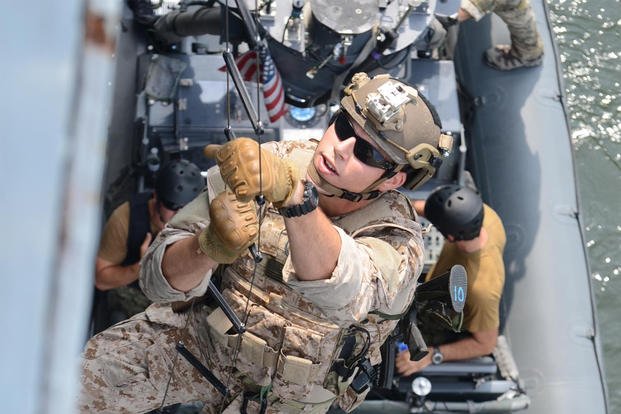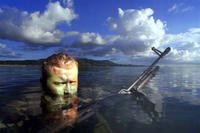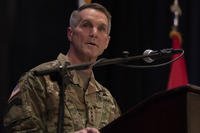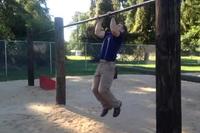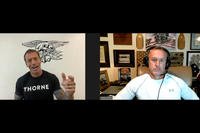Special Operations is characterized by the use of small units with unique ability to conduct military actions that are beyond the capability of conventional military forces. SEALs are superbly trained in all environments and are the masters of maritime Special Operations. SEALs are required to utilize a combination of specialized training, equipment and tactics in completion of Special Operation missions worldwide.
A tactical force with strategic impact, Naval Special Warfare (NSW) mission areas include unconventional warfare, direct action, combating terrorism, special reconnaissance, foreign internal defense, information warfare, security assistance, counter-drug operations, personnel recovery and hydrographic reconnaissance. Although NSW personnel comprise less than 1% of U.S. Navy personnel, they offer big dividends on a small investment. SEALs' proven ability to operate across the spectrum of conflict and in operations other than war in a controlled manner -- and their ability to provide real-time intelligence and eyes on target -- offers decision-makers immediate and virtually unlimited options in the face of rapidly changing crises around the world.
The most important trait that distinguishes Navy SEALs from other military forces is that SEALs are maritime special forces, as they strike from and return to the sea. SEALs (Sea, Air, Land) take their name from the elements in and from which they operate. Their stealth and clandestine methods of operation allow them to conduct multiple missions against targets that larger forces cannot approach undetected.
The Evolution of Naval Special Warfare
If one had to pick the origin of modern Naval Special Warfare, it could be said that the landing on Tarawa in November 1943 validated the need for pre-assault reconnaissance and obstacle-removal specialists. The Navy responded to the need by transforming the character of naval combat demolition units into underwater demolition teams (UDT). Frogmen from UDT-1 and UDT-2 first moved onto the tactical scene in January 1944 at Kwajalein and Roi-Namur, blasting coral and eliminating invasion obstacles. The community increased to more than 30 teams by the end of World War II and saw action throughout the Pacific and at Normandy.
UDTs expanded their mission during the Korean War when their demolition expertise proved invaluable in clearing mines in Wonsan Harbor. In 1954, the UDTs were reorganized into UDTs 11 and 12 at Coronado, California, and UDTs 21 and 22 at Little Creek, Virginia; however, UDT-22 subsequently was disestablished in 1956. Through the end of the decade, UDTs subsisted within the Navy like other specialty offshoots; they provided a necessary service but had little influence on war planning.
Chief of Naval Operations Adm. Arleigh Burke recognized that future hostilities would involve guerrilla activities, and in March 1961, he recommended forming naval special forces to counter the threat. In an address to Congress on May 25, 1961 -- shortly after the Bay of Pigs incident -- President John F. Kennedy emphasized the need to "expand rapidly and substantially, in cooperation with our allies, the orientation of existing forces for the conduct of non-nuclear war, paramilitary operations and sub-limited or unconventional war."
This led to the development of National Security Action Memorandum 57, "Responsibility for Paramilitary Operations" on June 28, 1961, which prompted each branch of the armed forces to form its own counter-insurgency force. The Navy utilized UDT personnel to form separated units called Sea-Air-Land (SEAL) teams. SEAL Teams 1 and 2 were commissioned in January 1962.
Throughout 1963 and 1964, SEALs operated in Vietnam as instructors to South Vietnamese frogmen. Their tasking steadily expanded, and by 1966, SEALs were stalking Viet Cong in the Rung Sat Special Zone in Operation Game Warden. Integrated with Helicopter Attack Squadron Light (HAL) 3, Attack Squadron Light 4 and Patrol Boat, River forces, SEAL tactics soon gained respect. In support of efforts to disrupt supply lines from Cambodia, HAL-3 transported special warfare personnel on more than 6,000 missions during 1970.
NSW gained momentum after the Vietnam War when Cambodians seized SS Mayaguez in May 1975. The incident reinforced the need for quick-response maritime special operations forces.
Middle Eastern terrorism began to impact the American psyche in the late 1970s and culminated in the Iranian hostage crisis. The calamity of Operation Desert Rescue in 1980 accentuated the need to merge and standardize crisis response forces from the several services into a cohesive organization. In 1983, existing UDTs were reconfigured and redesignated as either SEAL teams or swimmer delivery vehicle teams. Shortly afterward, President Ronald Reagan unleashed Operation Urgent Fury. The preemptive assault on Grenada proved to be a real-life test of the new NSW organization.
The evolution of Naval Special Warfare forces was subject to the military and political forces that were on the move in the mid-1980s within the U.S. government. The Goldwater-Nichols Defense Reorganization Act of 1986 sought "to place clear responsibility on the commanders of the unified and specified combatant commands for the accomplishment of missions." The approach established combatant commands to ensure unity of effort in using forces from the several services. The United States Special Operations Command (SOCOM) was assigned the responsibility of "providing trained and combat-ready special operations forces to the combatant commander and when directed by the President or Secretary of Defense for exercising command of selected special operations missions." Special operations forces were assigned missions of unconventional warfare, direct action, strategic reconnaissance, foreign internal defense, civilian affairs, psychological warfare, counterterrorism, humanitarian assistance, and theater search and rescue.
The Navy was reluctant to relinquish its NSW forces to SOCOM but eventually complied in July 1987 when it established the Naval Special Warfare Command (NSWC) as the naval component commander to SOCOM. By this time, there were about 1,300 SEALs among six SEAL teams, a 50% increase in personnel since 1983.
In the buildup for Operation Desert Storm, NSWC deployed an NSW group to the theater. Once in place, SEALs conducted strategic reconnaissance, early warning patrols, hydrographic reconnaissance, direct action, mine hunting, and combat search and rescue.
After Sept. 11, 2001, the Navy SEALs' evolution and years of training made for perfect positioning as they were poised to attack the terrorists in their own backyard. Before the end of 2011, the Navy SEALs had a large hand in defeating the Taliban in Afghanistan (Operation Anaconda) and driving Osama bin Laden and the senior leaders of al-Qaeda into hiding.
In March 2002, the NSWC added two new SEAL teams, bringing the total to four East Coast teams and four West Coast teams. The new teams were badly needed during the wars of Iraq and Afghanistan. Most of Naval Special Warfare conducted a variety of missions in both countries to include hunting and capturing of bomb makers, terrorist group leaders and gathering intelligence for future missions.
From 2001 to the present day, Navy SEALs have scoured the globe in search of terrorists, pirates and war criminals, conducting hostage rescue missions, and capturing and killing high-ranking terrorist leaders. These missions culminated in May 2011 with the killing of bin Laden, the mastermind of the 9-11 attacks, in a highly publicized raid in Pakistan.
Ready to Join the Military?
We can put you in touch with recruiters from the different military branches. Learn about the benefits of serving your country, paying for school, military career paths, and more: sign up now and hear from a recruiter near you.

